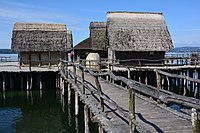Join Augustin, Alex, Lisa and the whole ArkeoTopia team to explore additional resources for step 6.1 of My Archaeology Book on analyzing archaeological remains in the lab by studying traces of wear that indicate how the artifact was used.
Step 6.1 – In the lab
Analyzing Use-Wear on Objects
Corresponding pages in MAB1 and MAB2
MAB 1, p. 24 and MAB 2, p. 30
More about this step’s reference artifact
Wear marks, and in particular the marks on flint blade 883 from Charavines in France, inspired the drawing on pages 24 and 30 of My Archaeology Book, titled Analyzing Use-Wear on Objects. Archaeologists use this method of analysis to understand why an artifact was created and what it was used for before being lost or discarded.

 Archaeologists do not limit themselves to excavating on land or in the ocean – they excavate in lakes as well! That is exactly how the underwater excavations in Charavines uncovered a century’s worth of information about everyday life in the villages around Paladru. These villages were on dry land at the time but are now underwater. Similar Neolithic pile-dwelling, or stilt house, settlements were inducted into UNESCO’s World Heritage Sites List on June 27, 2011 under the name Prehistoric Pile Dwellings around the Alps. UNESCO took action in order to protect the archaeological remains of prehistoric dwellings at all 111 sites, spreading across lakes and wetlands in the Alpine regions of Switzerland, Austria, France, Germany, Italy and Slovenia.
Archaeologists do not limit themselves to excavating on land or in the ocean – they excavate in lakes as well! That is exactly how the underwater excavations in Charavines uncovered a century’s worth of information about everyday life in the villages around Paladru. These villages were on dry land at the time but are now underwater. Similar Neolithic pile-dwelling, or stilt house, settlements were inducted into UNESCO’s World Heritage Sites List on June 27, 2011 under the name Prehistoric Pile Dwellings around the Alps. UNESCO took action in order to protect the archaeological remains of prehistoric dwellings at all 111 sites, spreading across lakes and wetlands in the Alpine regions of Switzerland, Austria, France, Germany, Italy and Slovenia.
This step also highlights that archaeologists work not only in the field, but in the lab as well. When the work of Russian archaeologist Sergei A. Semenov (1898-1978) was published in English in 1964, archaeology acquired a new method to complement the study of physical characteristics: use-wear analysis, or microwear analysis.

 Just as the manufacturing process can leave marks on an object as well as the tool used to manufacture it, so can using the object once finished. For example, the mallet and stone chisel are used by stonecutters to refine the shape of the stone but also leave marks in the process: the stone chisel leaves deep grooves on the capital, and the mallet leaves strike marks on the stone chisel. These wear marks result in wear patterns on the tools, as shown in the photo.
Just as the manufacturing process can leave marks on an object as well as the tool used to manufacture it, so can using the object once finished. For example, the mallet and stone chisel are used by stonecutters to refine the shape of the stone but also leave marks in the process: the stone chisel leaves deep grooves on the capital, and the mallet leaves strike marks on the stone chisel. These wear marks result in wear patterns on the tools, as shown in the photo.
Archeologists make a distinction between wear that can be seen at 50x or less magnification, called “use-wear” and that which can only be seen at more than 50x, called “microwear”. In the interest of simplicity, there is no distinction made here and instead the term use-wear is employed regardless of the magnification used. Each set of wear marks has an identifiable signature. For example, using a flint blade to cut meat will leave a recognizable shine on the blade and a deposit of organic matter, while using a blade to scrape will leave striations.

Archaeologists study wear patterns to determine two important pieces of information about the artifact. Use-wear analysis helps archaeologists determine the function of an artifact by answering the question: what was the intended function of this artifact when it was made? How was it meant to be used? However, people do not always use objects for their intended purpose. For example, forks are meant to spear food so we can bring it to our mouth, but they can also be used in other ways, such as to slice butter. In this case, archaeologists would determine the actual usage of an artifact, which is a deviation from its primary function. Use-wear analysis helps to understand this deviation by answering the question: what was this artifact actually used for? In other words, what was its use?
Lisa the archaeologist uses her stereo microscope to examine the Charavines blade and its signature marks under different magnifications. Along with Gnasher, Lisa determines that blade 883, which dates to between 2670 and 2590 BCE, is a double-edged sickle that was used to cut plant matter. This observation leads Lisa to connect the dots using what she knows about ethnology: this blade was attached to a haft, or handle, in order to harvest rice.
Clues
The 6 clues include:
- The flint blade found by Lisa the archaeologist in Charavines
- The stereo microscope, an essential tool for scientists who wish to see the slightest marks left by an object’s use – here, it magnifies the marks so Lisa can understand what the blade was used for
- Lisa the archaeologist, dressed in street clothes, operating the stereo microscope and handling the artifact – these images collectively represent a scientist working in a lab
- Gnasher, the clever rat, who represents human intelligence working to understand human History
- The close-up drawing of the Charavines blade, showing what Lisa the archaeologist sees under the stereo microscope
- The drawing of how a tool is used today in some regions of China, showing what Lisa the archaeologist deduces from the marks left on the Charavines blade: that the blade was used to harvest cereals
Labeling TechniquesMy Archaeology Book
Resources HomepageStep 6.2 – In the Lab
Technical Drawing



